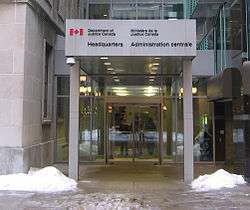Department of Justice (Canada)
Coordinates: 45°25′13″N 75°42′13″W / 45.42028°N 75.70361°W
| Ministère de la Justice du Canada | |
|
| |
| Department overview | |
|---|---|
| Formed | 1868 |
| Type | Department responsible for oversight of the Canadian justice system |
| Jurisdiction | Canada |
| Employees | Over 5,000 |
| Minister responsible | |
| Child agencies |
|
| Website |
canada |
The purpose of the Department of Justice (French: Ministère de la Justice du Canada) is to ensure that the Canadian justice system is fair, accessible and efficient. The department represents the Canadian government in legal matters. Almost all lawyers in the federal government are employed by Justice and are dispatched to manage the legal affairs of the other departments and agencies.
While the role of the Minister existed since 1867, the department was not created until 1868.
The headquarters of the Department of Justice is located at St. Andrew's Tower (275 Sparks Street), a modern low rise office tower built in 1987.
The current Minister of Justice (and Attorney General) is Jody Wilson-Raybould.
Structure
- Minister of Justice and Attorney General
- Deputy Minister (list)
- Associate Deputy Ministers
- Chief General Counsel
- Director General, Corporate Secretariat
- Director, Audit and Management Studies
- Executive Director, Office of Strategic Planning and Performance Management
- Director, Public Prosecutions Service of Canada
- Assistant Deputy Minister, Business and Regulatory Law Portfolio
- Assistant Deputy Attorney General, Aboriginal Affairs
- Assistant Deputy Attorney General, Litigation
- Assistant Deputy Attorney General, Tax Law
- Assistant Deputy Attorney General, Citizenship, Immigration and Public Safety Portfolio
- Assistant Deputy Minister, Central Agencies Portfolio
- Assistant Deputy Minister, Public Law Group
- Senior Assistant Deputy Minister, Policy Group
- Assistant Deputy Minister, Corporate Services
- Chief Legislative Counsel, Legislative Services
- Senior Regional Director, Atlantic Regional Office
- Senior Regional Director, Ontario Regional Office
- Senior Regional Director, Quebec Regional Office
- Senior Regional Director, B.C. Regional Office
- Senior Regional Director, Prairies Regional Office
- Senior Regional Director, Northern Region
- Director General, Communications
- Associate Deputy Ministers
- Deputy Minister (list)
History

Former Ministers of Justice include:
At the time of Confederation in 1867, the province of Canada had two Crown Law Departments, one for Canada West (now Ontario) and one for Canada East (now Quebec). At Confederation, the Crown Law Department, Canada West began to act as the new Department of Justice, reporting to Sir John A. Macdonald, who was Minister of Justice, Attorney General, and the new Prime Minister. The Crown Law Department, Canada East became the new Department of the Militia, following its former Attorney General, George-Étienne Cartier.
The Department of Justice came into being in May 1868, when the Department of Justice Act was passed by Parliament. The Act formally recognized the informal structure that was already in place. The Act also laid out the distinct roles of the Minister of Justice and the Attorney General: the Minister was a partisan political adviser to the Crown, while the Attorney General provided legal services.
The new Department of Justice had only seven staff: two barristers-at-law (including the Deputy Minister, Hewitt Bernard), a clerk and shorthand writer (Macdonald's personal secretary), a copy clerk, a clerk articling under Macdonald, and two messengers.
The legal branch of the department remained relatively small for many years. As late as 1939, the Department employed only seven lawyers. The department's first woman lawyer, Henrietta Bourque, was hired in 1939, but the department remained heavily male-dominated. In the 25 years between 1939 and 1964, only five female lawyers were hired by the department.
Although the Department of Justice Act had given the department responsibility for all litigation for or against the government, many government departments hired their own lawyers to provide them with legal advice. In 1962, however, these departmental lawyers were brought together in a common legal service. Although many lawyers still work closely with other government departments in department legal services units, they are now considered to be employees of the Department of Justice.
Regional offices were opened in Montreal (1965), Toronto (1966), Vancouver (1967), Winnipeg (1969), Halifax, Edmonton, Saskatoon, the Northwest Territories, and Iqaluit (Nunavut). The Department of Justice co-chaired the Interdepartmental Working Group on Trafficking in Persons with the Department of Foreign Affairs, Trade and Development from 1999[1] until 2012.[2]
The department employs 5,000 people, nearly half of whom are lawyers, in offices across the country.
Current initiatives
Former Prime Minister Stephen Harper called for plans to create a Director of Public Prosecution as an independent role to deal with criminal cases involving government and public officials.
See also
References
- ↑ Combatting Trafficking in Persons: A Handbook for Parliamentarians (16 ed.). United Nations. 2009. p. 99.
- ↑ "Optional Protocol to the Convention on the Rights of the Child on the Sale of Children, Child Prostitution, and Child Pornography" (PDF). Canadian Coalition for the Rights of Children. October 5, 2012. p. 2. Retrieved October 21, 2013.
External links
- Department of Justice Canada (English)
- Department of Justice Canada (French)